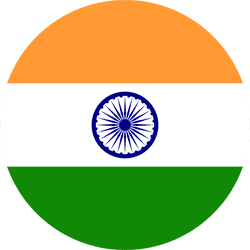Categories(658 Blogs)
Select Category
Watch Right Now
Teacher App - Class
Schedule & Attendance Management App
Parent App from Edsys

Best School Bus Tracking System

Cashless School - For Smart Schools of Tomorrow


15 Major Mountain Ranges in India: Oldest and Longest Mountain ranges in India
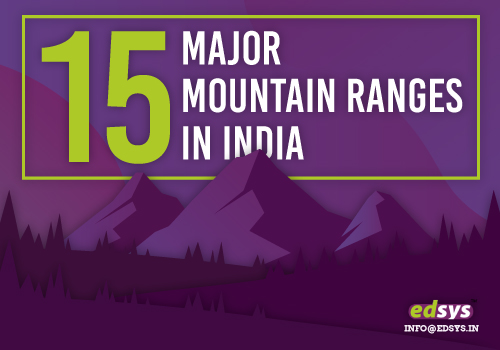
Mountain ranges in India
India has some of the major mountain ranges in the world. It is home to seven major mountain ranges which possess peaks of over 1000 meters.
Access Here More Than 1000+ FREE Educational Apps
In this Blog we cover,
- India and it’s Mountain ranges
- List of Mountain Ranges in India
- Oldest Mountain Ranges in India
- Longest and Youngest Mountain Ranges in India
- Highest Peaks in India
India and its Mountain ranges
India is a land of huge natural diversity. From snow-capped mountains to dry deserts and sandy coastlines, the natural landscape is as diverse as the culture and tradition of the nation.
There are many mountain ranges in India, including the longest and oldest mountain ranges in the world.
All these mountain ranges in India have a profound impact on the weather conditions, lifestyle, religious beliefs, and economic development of the country.
In this blog, we will explore the 15 major mountain ranges in India.
| Sl no | List of Mountain Ranges in India |
| 1 | The Himalayan Mountain Range |
| 2 | The Western Ghats |
| 3 | The Eastern Ghats |
| 4 | The Aravalli Mountain Range |
| 5 | The Karakoram and Pir Panjal Mountain Range |
| 6 | The Purvanchal Mountain Range |
| 7 | The Satpura and Vindhya Mountain Ranges |
| 8 | Zabarwan Range |
| 9 | Eastern Himalaya |
| 10 | Western Himalaya |
| 11 | Pachaimalai Hills |
| 12 | Kudremukh |
| 13 | Sivalik Hills |
| 14 | Kaimur Range |
| 15 | Lower Himalayan Range |
1) The Himalayan Mountain Range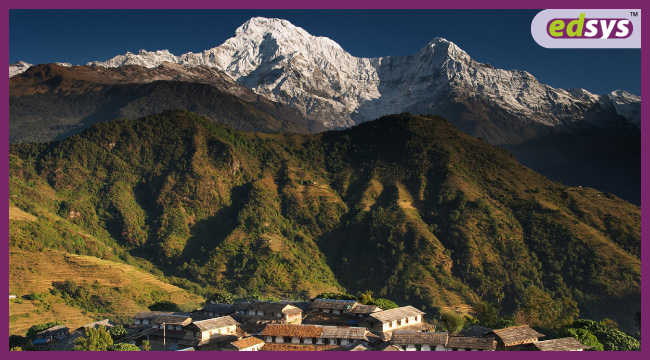
Best season to visit-Winter (December until Early-March)
How to get there – View Direction
The Himalayan Mountain Ranges is 2,400 kilometers long and traverses through five countries – India, Nepal, Tibet, Bhutan, and Pakistan.
It begins near the Indus River in Pakistan and ends near the Brahmaputra River in India.
The Himalayan states of India are Sikkim, Arunachal Pradesh, Himachal Pradesh, Uttarakhand, and Jammu and Kashmir.
When you look at the top view of this mountain range from space, it looks like an arch.
In terms of age, the Himalayas is quite a young mountain range as it was formed around 40 to 50 million years ago.
The word “Himalayas” is derived from Sanskrit and means “The Land of Snow.”
This huge mountain range consists of three parallel ranges, which are known as the Outer Himalayas (Shivalik range), the Greater Himalayas, and the Lesser Himalayas.
The Kali Gandaki Gorge is located at around 8000 kilometers distance from the start of the range. This gorge divides the mountain range into the Eastern and Western sections.
The world’s highest peak – Mount Everest as well as three of the six highest peaks of the world is in the east of the Himalayas, in the Mahalangur Himal region.
The other three peaks are Cho Oyu, Lhotse, and Makalu.
It is believed that the Himalayas have more than 1500 glaciers and hundreds of lakes that form the biggest source of freshwater for the Himalayan nations.
The rivers that originate in this mountain range are Ganges, Indus, Saraswathi, Yamuna, Yangtze, Ganga-Brahmaputra, Yarlung, and Nujiang.
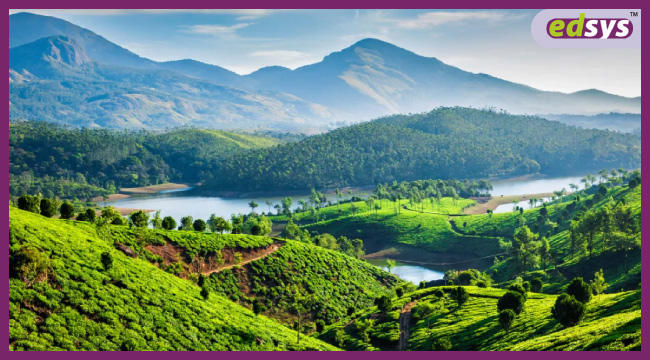
Best season to visit-After October
How to get there: View Direction
The Western Ghats is 1600 kilometers long, and extends from Gujarat to Tamilnadu, traveling through Maharashtra, Goa, Karnataka, and Kerala.
Geographical evidence shows that these mountain ranges are older than the Himalayas.
The Western Ghats are believed to have been formed about 150 million years ago.
These mountain ranges have been declared as UNESCO World Heritage Site for their biodiversity.
These Ghats are home to 7402 species of flowering plants, 6000 species of insects, 1814 species of non-flowering plants, 508 species of birds, 179 species of amphibians, 290 species of freshwater fishes, and 139 species of mammals.
Of these 325 species are in globally threatened status. There are 39 wildlife sanctuaries and national parks in the Western Ghats region.
The Western Ghats are not just protected for their biodiversity, but also because of their strategic influence on the monsoon rains.
These huge mountains act as a barrier to the south-west monsoon winds and divert the rain-laden winds towards the Indian subcontinent.
The major rivers that originate from the Western Ghats are Cauvery, Godavari, Krishna, Tungabadra, and Tamirabarani.
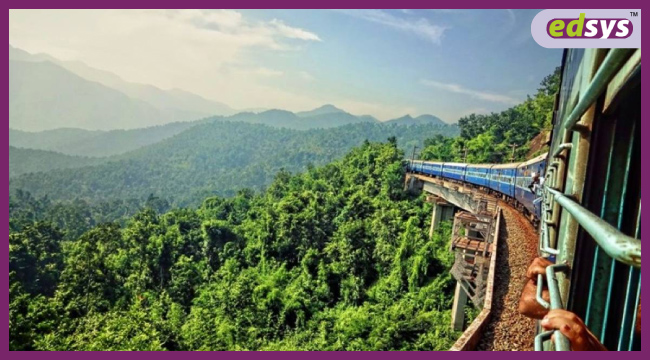
Best season to visit-Between October and March
How to get there: View Direction
The Eastern Ghats start from Odissa in the North and travel down to Tamilnadu, parallel to the Bay of Bengal. They pass through certain areas in Karnataka, Kerala, and Andhra Pradesh.
Unlike the Western Ghats, the Eastern Ghats are not a continuous mountain range.
Rivers flowing through the range have eroded the mountains creating huge gaps between stretches of undulating hills.
The four major rivers that flow through the Eastern Ghats are Cauvery, Godavari, Mahanadi, and Krishna. The rivers that originate in the Eastern Ghats are Rushikulya, Vamsadhara, Sarada, Sabari, Nagavalli, Palar, Champavathi, Gosthani, Sileru, Tammileru, Pennai, Swarnamukhi, Penna, Gundlakamma, Kundu, and Vellar.
This discontinuous mountain range is called by different names in different parts. In Odissa, these stretches are known as the Chandragiri-Pottangi mountain system and Garhjat Hills.
In Tamilnadu, these discontinuous stretches are known as Karanthamalai Hills, Sirumalai Hills, Pachamalai, Kollimalai, Kalrayan hills, Palani hills, Mettur hills, Servarayan hills, Javadhu Hills, and Shevaroy Hills.
Also Read: Top 12 Longest and Major Rivers in India
The Biligiriranga Hills and the Nilgiris Hills form the corridor between the Eastern and Western Ghats. In Karnataka, the mountain stretches are known as Male Mahadeshwara Hills.
In Andhra, they are known as the Seshachalam-Velikonda Range, Palikonda-Lankamalla-Nallamala Ranges, Kondapalli Hills, Papi Hills, Maliya Range, and Madugula Konda range.
4. The Aravalli Mountain Range
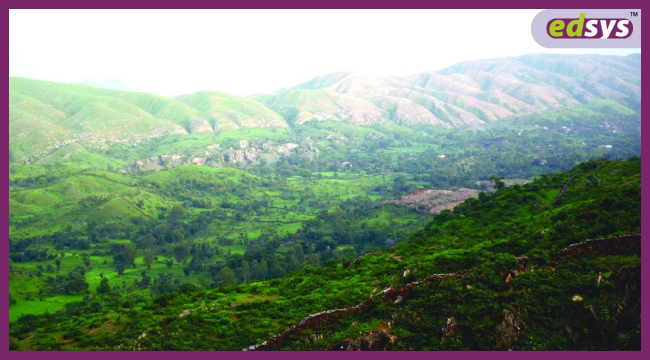
Best season to visit-November to February
How to get there- View Direction
The Aravalli Mountain ranges are one of the oldest ranges in the world. Geologists believe that these fold mountains existed even when the Indian subcontinent separated from the Eurasian plate.
Archeological excavations have found Harappa and Indus Valley Civilization sites in these mountain ranges.
The Aravalli Range extends from Delhi and travels in the south-western direction toward Gujarat, passing through South Haryana and Rajasthan.
A major portion of this mountain range lies in Rajasthan. Some parts of this mountain range contain thick forests and in other places have only sand and stone.
These mountains are a rich source of minerals such as rock phosphate, asbestos, talc, apatite, beryl, kyanite, lead, silver, and zinc.
The rich mineral deposits have to lead to excessive mining in this mountain region. Many naturalists are lobbying for the protection of these oldest fold mountains to prevent them from becoming completely destroyed.
These mountain ranges are the natural habitat of many flora and fauna. Plus, they create a natural barrier between eastern Rajasthan and the Thar Desert. The rivers that originate in the Aravalli hills are Sabarmati, Luni, Sakhi, Sahibi, and Banas.
5) The Karakoram and Pir Panjal Mountain Range
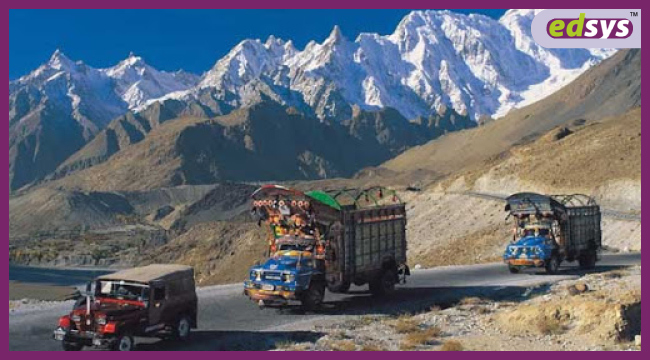
Best season to visit-March to August
How to get there: View on Map
These mountain ranges lie to the south and north-west of the Himalayas. A major part of the Karakoram Range lies in the disputed region between India and Pakistan.
This mountain range also passes through Jammu and Kashmir and Himachal Pradesh. Actually, the Pir Panjal range is a part of the Lesser Himalayas Mountain Range.
These mountains start from the Himalayas and separate from the range near the River Sutlej. From there, this range travels separately with Ravi and Beas rivers on one side and the Chenab River on the other side.
This mountain range boasts of the largest glacier outside the poles – The Siachen Glacier. The second highest peak in India and the third highest peak in the world – K2 is also in this mountain range.
There are many passes and tunnels in this mountain range. The Haji Pir Pass located in the western part of this mountain range connects Poonch and Uri.
The other passes are Rohtang Pass, Sinthan Pass, Banihall Pass, and Pir Panjal Pass.
Tunnels such as Jawahar Tunnel, Banihal Qazigund Road Tunnel, Atal Tunnel, and Banihal Railway Tunnel have improved accessibility to the villages and towns nestled in the Karakoram and Pir Panjal mountain range.
6. The Purvanchal Mountain Range
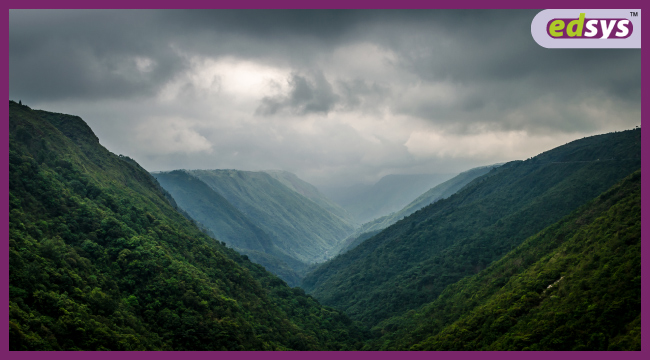
Best season to visit-Monsoon Season
How to get there – View Directions
The Purvanchal mountain range extends from the Himalayas toward the northeastern region of India, south of the Brahmaputra valley.
It travels through Arunachal Pradesh, Assam, Manipur, Tripura, Meghalaya, Mizoram, and Nagaland.
The hills in this mountain range are Kohima, Patkai, Barail, Khasi–Jaintia, Naga Hills, Lushai, Manipur, and Mizoram Mizo. This mountain range has the wettest place on earth – Cherrapunji.
7. The Satpura and Vindhya Mountain Ranges
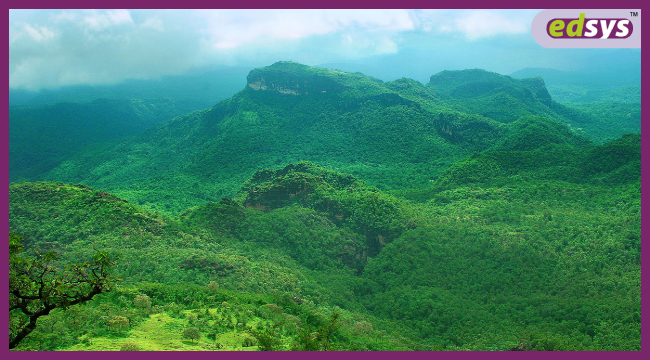
Best season to visit-October and February
How to get there- View Direction
The Satpura and the Vindya are parallel mountain ranges that pass through the central part of the country.
Also Read: 24 Most Popular National Festivals Of India
The Satpura mountain range is triangle shaped. The tip of the triangle is at Ratnapuri and the other two sides run parallel to the Tapti and Narmada Rivers that drain into the Arabian Sea.
This mountain range travels through Gujarat, Madhya Pradesh, Chhattisgarh, and Maharashtra.
The Vindhya mountain range is one of the oldest mountain ranges in India and is a discontinuous range of mountains. It travels from East to West through Madhya Pradesh and Gujarat.
The Vindhya hills near Champaneer end in a series of hills, which connect this mountain range with the Aravalli mountain range.
Tributaries of Ganga and Yamuna flow into the Vindhya mountain ranges. The tributaries are Ken, Chambal, Betwa, Kali Sindh, Parbati, and Dhasan.
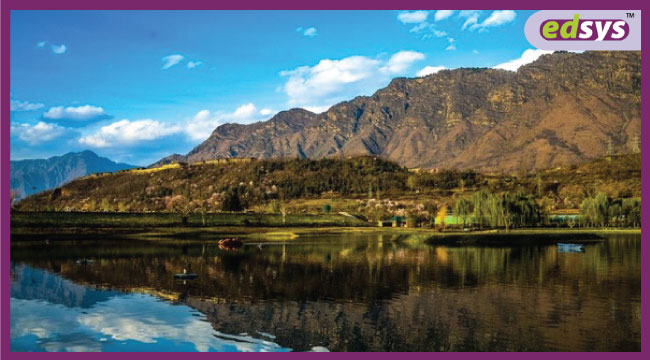
How to get there- Direction
Best season to visit- March to August
The Zabarwan Range is situated between Pir Panjal and Great Himalayan Range. It comes in the central part of the Kashmir valley in the union territory of Jammu and Kashmir.
The north part of Zabarwan range lies in Ganderbal and the south end lies in Pampore.
Madhav peak is the highest peak of this range.
This mountain range possesses rich wildlife and is a home to animals including jackal, leopard cat, musk deer, Himalayan brown bear, red fox, langur, Himalayan weasel, long-tailed marmot, serow, Indian porcupine etc.
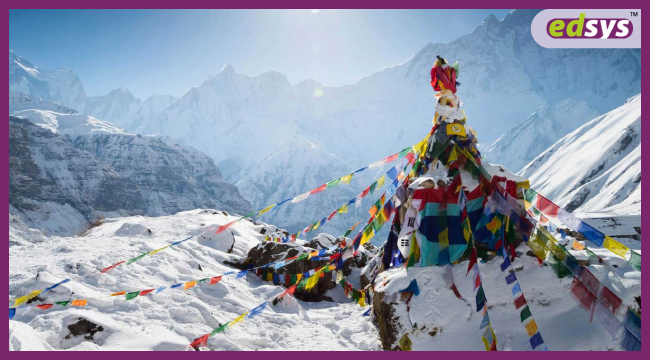
Best season to visit: Late October until early May
How to get there: View Direction
The Eastern Himalayas comprise the tracts of the Darjeeling Hills of North Bengal, eastern Bhutan, Arunachal Pradesh, and Sikkim.
The Eastern Himalayas can be divided into different climatic regions such as subtropical, sub-arctic, artic, and temperate.
The forests here are evergreen, semi-evergreen, moist, dense, or temperate. The subtropical forests cover the hills to an extent of about 2000m.
This place is home to a huge diversity of animals including clouded leopard, slow loris, the Indian civet, the golden languor, the golden cat, rhinoceros, etc.
Besides, it is also home to birds such as the snowcock, heron, the white-winged wood duck, and more.
According to reports, Eastern Himalayas is home to :
- 977 birds
- 269 freshwater fish
- 977 birds
- 10,000 types of plants
- 176 reptiles
- 300 mammals
- 105 amphibians
In Eastern Himalayas, a number of wildlife sanctuaries and biosphere reserves have been set up to protect the species from human encroachments and poachers.
This place harbors an amazing diversity of life.
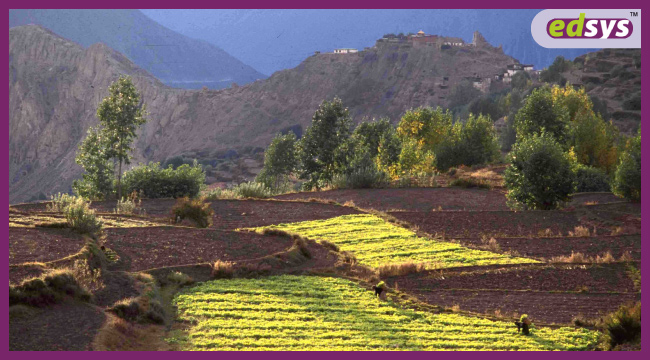
Best season to visit: Late October until early May
How to get there: View Direction
Western Himalayas or Punjab Himalayas are the westernmost part of the vast Himalayan Mountains. It lies in the regions of Kashmir,in the portions administered by India and Pakistan, and also in the northwestern part of Himachal Pradesh.
The Western Himalayas extend to the southeast region for 560 kilometers from Indus River to Sutlej River.
The five tributaries of Indus River from the Punjabi region originate from the Western Himalayas namely Beas, Chenab, Jhelum, Sutlej, and Ravi.
The Sivalik Range, Great Himalayas, Zanskar Range, the Pir Panjal Range, and the Dhola Dhar Range are included within Western Himalayas.
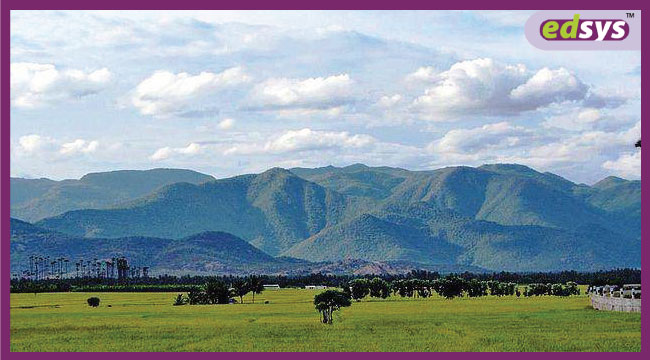
How to get there- Direction
Best season to visit- September- June
The Panchamalai Hills are a low mountain range in the Eastern Ghats System, also known as Pacha is. They lie in the state of Tamil Nadu, 80 km north of Tiruchirapalli, in the parts of southeastern India.
As the name denotes, ‘Pachai’ means ‘green’ in Tamil, the mountain range’s vegetation is greener than some of the other hills.
Pachaimalai hills have an altitude of about 500 m to 1000 meters above sea level.
Major rivers in this range are Kallar River and Sweata Nadi and waterfalls include Mayil Uthu falls, Mangalam Aruvi falls, Koraiyar Falls etc. The mountain ranges consist of small regions like Kombainadu, Athinadu, Thenparanadu.
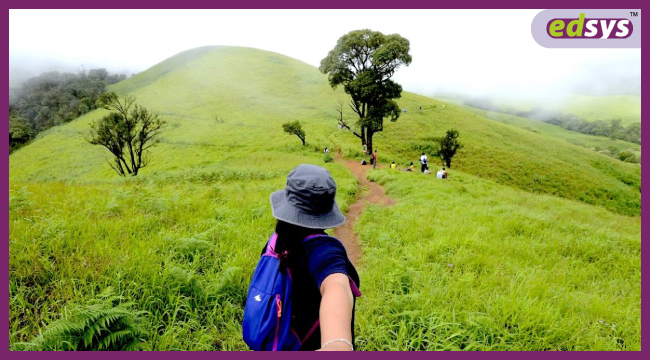
Best season to visit: March-May
How to get there: View Direction
Kudremukh is a mountain range and the name of a peak situated in Karnataka, India. It is the third highest peak in Karnataka. The mountain is named “Kudremukh because one side of this mountain resembles the face of a horse and hence the name. Kudremukh in Kannada means “horse-faced”.
This mountain range is covered by lush green forests, hills, lakes, and valleys, so is a paradise for the nature lover. It is the second-highest peak after Mullayanagiri.
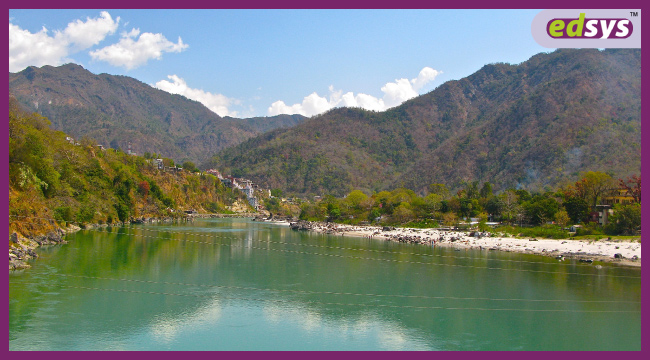
Best season to visit: September to November
How to get there: View Direction
Literally, ‘Sivalik’ means’ tresses of Shiva’. Sivalik Hills or Churia Hills are part of the outer Himalayas that extends from Indus River about 1500 miles eastwards to Bharathapuzha River. Though only 10 miles wide in places, Sivalik Hills have an average elevation of 3,000 to 4,000 feet. These ranges are the southern- most hills of the Himalayas. There exists a regular course from River Yamuna and River Ravi on the south of Western Himalaya.
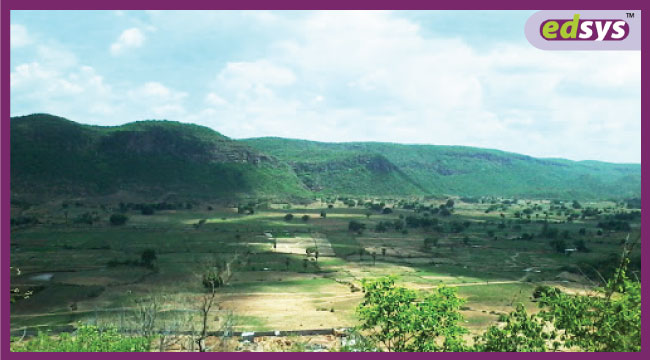
How to get there- Direction
Best season to visit- Jan- March, Oct-Dec
Kaimur Range , also known as Kaimur Hills is the eastern portion of the Vindhya Range. It is a hill range running across Bihar, Madhya Pradesh and Uttar Pradesh. It is about 483 kilometers long extending from Madhya Pradesh to Bihar.
The width of this range is about 50 miles. It is one of the most important spot of cultural and archaeological point of view. Antiquarian remains such as coins, potteries, prehistoric rock paintings, inscriptions etc have also been found here.
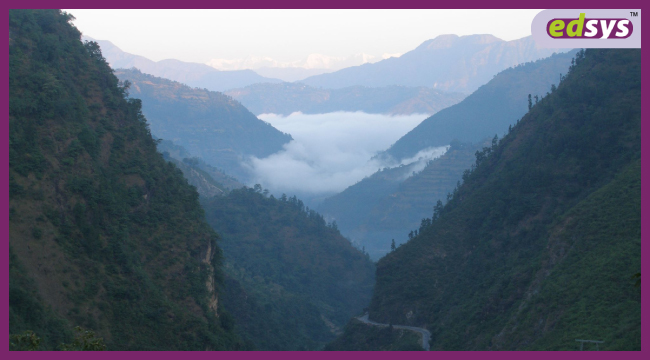
Best season to visit: late October until early May
How to get there: View Direction
Lower Himalayan Range is also known as Mahabharata Range, Lesser Himalaya, or the Himachal, with an elevation of about 3,700 – 4,500 m. The largest range of this major east-west mountain range is Pir Panjal
The Lower Himalayan Range parallels the much higher High Himalayan range from Indus in Pakistan to Sikkim, Bhutan, Nepal, and India. It also parallels the Outer Himalayas to the south.
Oldest Mountain Range in India
Aravalli Range
Literally Aravalli means, ‘line of peaks’. Eroded by the ancient mountains, Aravalli Ranges are the oldest range of fold mountains in India. The origin can be traced back to times when the Indian Plate was separated from the Eurasian Plate by an ocean.
Youngest Mountain range in India & Longest Mountain Range in India
Himalayan Range
The most famous Himalayan ranges are the youngest and longest mountain ranges in India. It also has almost every largest peak of the world.
The Himalayan mountain ranges are the primary source of many mighty rivers in India.
50 Highest Peaks of India
| Sl no | Mountain | Height | State | Range |
| 1 | Kangchenjunga | 8586 | Sikkim | Kangchenjunga Himalaya |
| 2 | Nanda Devi | 7816 | Uttarakhand | Garhwal Himalaya |
| 3 | Kamet | 7756 | Uttarakhand | Garhwal Himalaya |
| 4 | Saltoro Kangri/K10 | 7742 | Jammu and Kashmir | Saltoro Karakoram |
| 5 | Saser Kangri I/K22 | 7672 | Jammu and Kashmir | Saser Karakoram |
| 6 | Mamostong Kangri | 7516 | Jammu and Kashmir | Rimo Karakoram |
| 7 | Saser Kangri II E | 7513 | Jammu and Kashmir | Saser Karakoram |
| 8 | Saser Kangri III | 7495 | Jammu and Kashmir | Saser Karakoram |
| 9 | Teram Kangri I | 7462 | Jammu and Kashmir | Siachen Karakoram |
| 10 | Jongsong Peak | 7462 | Sikkim | Kangchenjunga Himalaya |
| 11 | K12 | 7428 | Jammu and Kashmir | Saltoro Karakoram |
| 12 | Kabru N | 7412 | Sikkim | Kangchenjunga Himalaya |
| 13 | Ghent Kangri | 7401 | Jammu and Kashmir | Saltoro Karakoram |
| 14 | Rimo I | 7385 | Jammu and Kashmir | Rimo Karakoram |
| 15 | Teram Kangri III | 7382 | Jammu and Kashmir | Siachen Karakoram |
| 16 | Kirat Chuli | 7362 | Sikkim | Kangchenjunga Himalaya |
| 17 | Mana | 7272 | Uttarakhand | Garhwal Himalaya |
| 18 | Apsarasas Kangri | 7245 | Jammu and Kashmir | Siachen Karakoram |
| 19 | Mukut Parbat | 7242 | Uttarakhand | Garhwal Himalaya |
| 20 | Rimo III | 7233 | Jammu and Kashmir | Rimo Karakoram |
| 21 | Singhi Kangri | 7202 | Jammu and Kashmir | Siachen Karakoram |
| 22 | Hardeol | 7161 | Uttarakhand | Garhwal Himalaya |
| 23 | Chaukhamba I/Badrinath | 7138 | Uttarakhand | Garhwal Himalaya |
| 24 | Nun-Kun | 7135 | Jammu and Kashmir | Zanskar Himalaya |
| 25 | Pauhunri | 7128 | Sikkim | Sikkim Himalaya |
| 26 | Pathibhara/The Pyramid | 7123 | Sikkim | Kangchenjunga Himalaya |
| 27 | Trisul I | 7120 | Uttarakhand | Garhwal Himalaya |
| 28 | Satopanth | 7075 | Uttarakhand | Garhwal Himalaya |
| 29 | Tirsuli | 7074 | Uttarakhand | Garhwal Himalaya |
| 30 | Chong Kumdang Ri | 7071 | Jammu and Kashmir | Rimo Karakoram |
| 31 | Dunagiri | 7066 | Uttarakhand | Garhwal Himalaya |
| 32 | Kangto | 7060 | Arunachal Pradesh | Assam Himalaya |
| 33 | Nyegyi Kansang | 7047 | Arunachal Pradesh | Assam Himalaya |
| 34 | Padmanabh | 7030 | Jammu and Kashmir | Rimo Karakoram |
| 35 | Shudu Tsempa | 7024 | Sikkim | Sikkim Himalaya |
| 36 | Chamshen Kangri/Tughmo Zarpo | 7017 | Jammu and Kashmir | Saser Karakoram |
| 37 | Aq Tash | 7016 | Jammu and Kashmir | Rimo Karakoram |
| 38 | Chong Kumdang Ri II | 7004 | Jammu and Kashmir | Rimo Karakoram |
| 39 | Rishi Pahar | 6992 | Uttarakhand | Garhwal Himalaya |
| 40 | Thalay Sagar | 6984 | Uttarakhand | Garhwal Himalaya |
| 41 | Mt. Lakshmi | 6983 | Jammu and Kashmir | Rimo Karakoram |
| 42 | Kedarnath Peak | 6968 | Uttarakhand | Garhwal Himalaya |
| 43 | Langpo | 6965 | Sikkim | Sikkim Himalaya |
| 44 | Saraswati Parvat I/Saraswati Peak | 6940 | Uttarakhand | Garhwal Himalaya |
| 45 | Shahi Kangri | 6934 | Jammu and Kashmir | Central Tibetan Plateau |
| 46 | Sri Kailas | 6932 | Uttarakhand | Garhwal Himalaya |
| 47 | Kalanka | 6931 | Uttarakhand | Garhwal Himalaya |
| 48 | Chorten Nyima Ri | 6927 | Sikkim | Sikkim Himalaya |
| 49 | Saf Minal/Pk 6911 | 6911 | Uttarakhand | Garhwal Himalaya |
| 50 | Panchchuli II | 6904 | Uttarakhand | Garhwal Himalaya |
Access Here More Than 1000+ FREE Educational Apps
So that’s about the major mountain ranges in India. Hope you all have got a clear vision about the major mountain ranges in India, after reading this blog.
So finally,
These mountain ranges in India are treasure troves of natural resources. They travel through the entire length and breadth of the Indian subcontinent.
These are not just homes to the numerous flora and fauna but have also played a vital role in shaping the culture, tradition, and economy of the regions surrounding them.
Recent Blogs
Our Educational Services
Popular Blogs
Subscribe

SUBSCRIBE TO OUR NEWSLETTER
Sign Up and Recieve the Latest News
Don’t Worry, We Don’t SpamExplore Our Extensive Researched Educational App Directory
Visit Now